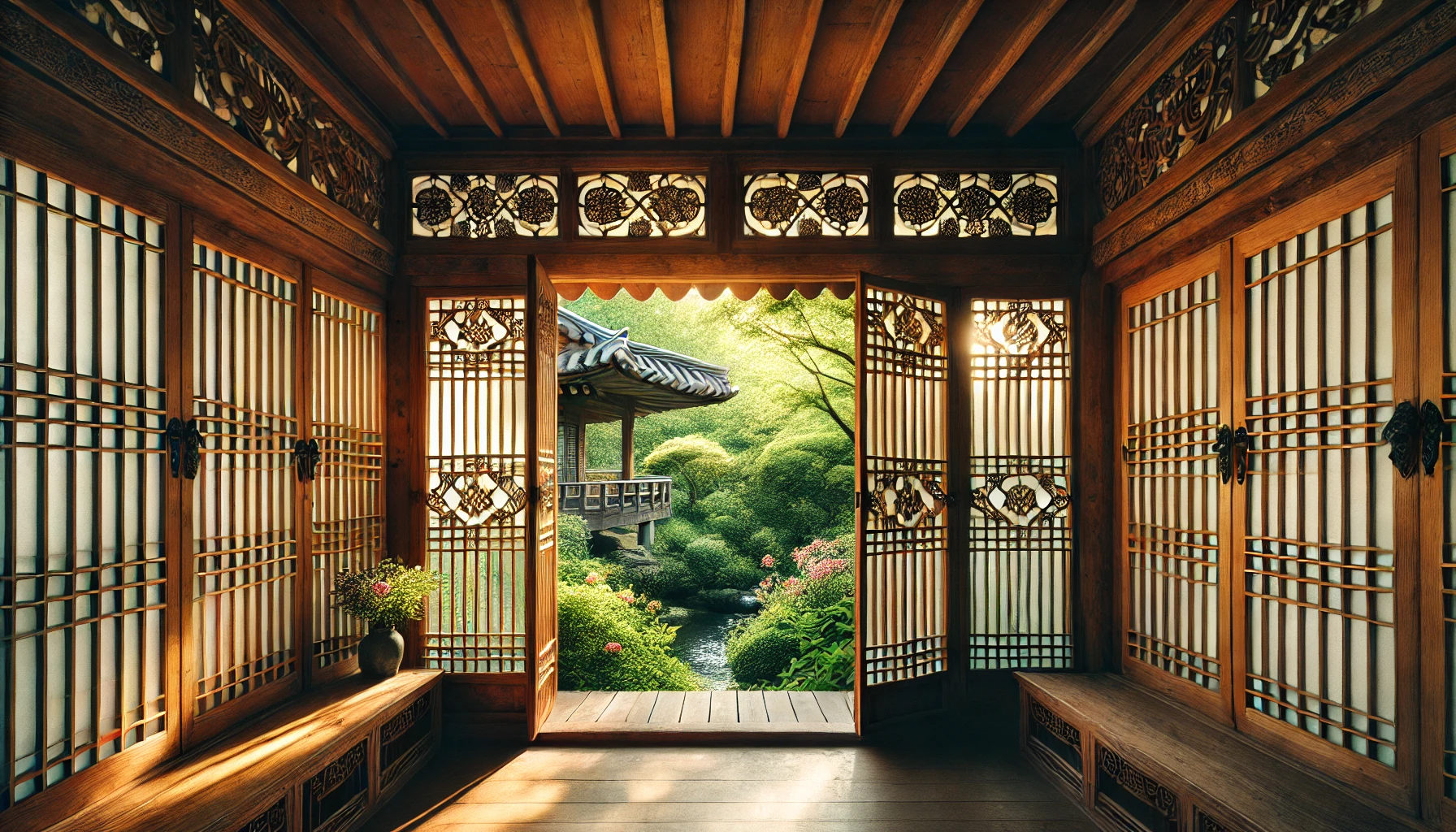A combination of a window and a door, windows play a functional and aesthetic role in hanoks, providing variability in space and harmonizing with nature. They are also an important element of modern architecture that incorporates traditional aesthetics.
Windows are used for light and ventilation, and doors are openable facilities installed on the walls of buildings to allow people to enter and exit. In general, in modern architecture, windows and doors are easy to distinguish because of their clear functions and different sizes and shapes. However, in traditional Korean architecture, or hanok, windows and doors are often similar in size and shape, so they are often not distinguished. As a result, windows and doors are combined together and called changho (窓戶). This means that windows and doors share the same functions and aesthetics. However, if you want to distinguish between windows and doors, you can do so through an architectural component called a mullion. A mumm is a low windowsill installed below a window, at a comfortable height for leaning on with arms resting on it.
More than just functional, hanok windows play a key role in the hanok, which is characterized by the variability of space. Large windows in pairs sometimes replace an entire wall, and by opening not only the windows facing the outside, but also the windows between rooms and rooms, separate spaces merge to form a large new space. The opening and closing of the windows connects or separates the inside and outside spaces and changes the division of the interior space. As such, windows play an indispensable role in the spatial organization of hanok.
On the other hand, windows are a unique element in hanoks that showcase the aesthetics of the architecture. When the window is open and there are natural objects such as trees or flowers outside, if you look out from inside the room at a certain distance from the window, you will see a landscape painting within the outer perimeter of the window. The interior space of a hanok is transformed into an aesthetic space that is one with nature by allowing people inside the room to fully communicate with nature outside the room and directly receive the beauty of nature rather than artificial beauty. The open windows erase the boundaries between inside and outside, between people and nature.
In addition, the role of windows in hanoks is emphasized by the changing seasons. In spring and summer, the windows are opened to let in warm sunlight and cool breezes, while in fall and winter, the windows are closed to keep out the cold, but the soft sunlight streaming through the window panes makes the room cozy. In this way, windows go beyond simple opening and closing to provide different beauty and functions for each season, enriching the life of a hanok.
When the window is closed, the grate pattern and window paper play an important aesthetic function. In hanoks, window paper is applied to the grate on the room side. When viewed from outside the room, the symmetrical arrangement of the grates creates a pattern of clean lines. The different patterns of the grilles give the house a distinctive look, and the homeowner’s character. When viewed from inside the room, the window panes have a blue-gray color in the early morning sunlight, a pure milky color when the midday sunlight enters, and the red color of the sunset at the end of the day. The thinness of the window panes also allows communication with the outside world even when the windows are closed. You can hear the wind and birds outside, and feel the emotions and moods of sunny and cloudy days from inside the room. In this way, windows allow for constant communication between people and nature, allowing both to live in harmony with each other.
Hanok windows are also highly valued for their sculptural beauty. The delicate grate patterns on the windows not only beautify the exterior of the hanok, but also visually represent the passage of time through the light and shadows that enter the interior space. This transforms the interior space from a mere living space to an artistic one. These qualities of windows have led to various attempts to bring the traditional aesthetic of hanok into the modern era. Modern architects are using hanok window designs as motifs for new buildings, or incorporating the beauty of hanok windows into existing buildings to create spaces that harmonize tradition and modernity.

As you can see, windows are more than just opening and closing facilities, they play an important role in the spatial organization, aesthetics, and harmony with nature of hanoks. It is an important task for us to think about how to apply these traditional elements to modern architecture. Window designs that inherit tradition and satisfy modern practicality and aesthetics at the same time will play an important role in illuminating the future of Korean architecture. Through windows, we can learn about the aesthetics of living in harmony with nature, beyond the boundaries of mere architecture.
Finally, hanok windows are also important for their maintenance and preservation. While many modern buildings are losing their traditional elements in favor of simple economy and convenience, hanok windows have not lost their value in the face of this trend. The preservation and management of windows is not just about maintaining old buildings, but also plays an important role in transmitting our cultural heritage to future generations. Therefore, it is necessary to reinterpret the windows of hanoks in a modern way and create a new architectural culture that harmonizes tradition and modernity. Such efforts will have a profound impact on our lives and culture as a whole, beyond just the aesthetic value of architecture.
